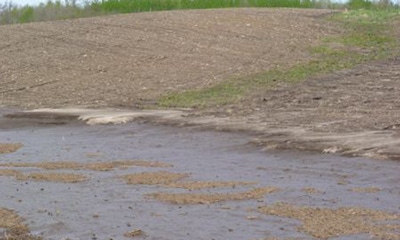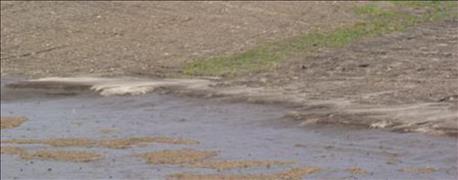June 13, 2016

An amended 1984 state soil-erosion law is getting teeth.
The Minnesota Soil Erosion Law passed the 2015 Legislature, becoming a complaint-based measure that enables statewide consequence for agricultural erosion situations formerly governed by counties. More stick than carrot, a written complaint to a county about excessive soil erosion triggers a soil and water conservation district investigative farm site visit, remediation plan and potential $500 fine.

Amended state erosion law allows for filing of citizen complaints
Overseen by the Minnesota Board of Soil and Water Resources, the amended Minnesota Soil Erosion Law would broaden an existing 1984 law prohibiting a person from causing ‘excessive soil loss,’ says Doug Thomas, BWSR assistant director of regional operations.
It defines ‘excessive soil loss’ by using longstanding Natural Resources Conservation Service-established ‘T’ levels. In Minnesota, these generally reflect soils’ threshold for productivity loss, or three to five tons of soil lost per year, depending on soil type, farming practices and topography.
A number of farmers contacted for this story had not heard of the Soil Erosion Law. Possibly, it may have been overshadowed, due to the state’s recent buffer law. The expanded penalties in the Minnesota Soil Erosion Law are independent of the new Minnesota Buffer Law, Thomas says.
How the program will work
The revised 2015 soil erosion law enables a citizen to file a signed written erosion complaint to trigger enforcement measures. Any Minnesotan can submit a confidential written complaint reporting excessive soil erosion and the associated landowner. The local Soil and Water Conservation District schedules a site visit with the landowner to investigate evidence of excess erosion or sedimentation.
If the erosion complaint is groundless, the county dismisses it. If it documents excessive soil loss, as defined above, the county stipulates a SWCD-written conservation plan with corrective-action deadlines. The landowner has 90 days to seek cost-share program funding through its local SWCD, state and/or federal programs.
Local counties have the enforcement role and local SWCD continue to play a technical support role, with site inspections, conservation plan and possible cost share. The SWCD remains a non-enforcement body.
A landowner who disagrees with the finding enters a mediation process and may be subject to a penalty of up to $500. More details are available at http://bwsr.state.mn.us/buffers/Soil_Erosion_RFI.pdf.
Voluntary versus mandatory
Farm conservation has traditionally been voluntary, driven by farmers’ economic self-interest in preserving their soil assets’ productivity. Minnesota SWCDs have provided and still provide technical assistance. That does not change with the 2015 law.
“No one disagrees with reducing soil erosion and nutrient loss,” says Mike Petefish, a Dodge County corn/soybean farmer. “But this law treats voluntary conservationists and less conservation-minded farmers the same way. A farmer could be guilty until proven innocent.” He also thinks an anonymous erosion complaint should be part of the public record.
�“We already had a complaint-based system,” says Ian Cunningham, president of the Minnesota Association of SWCDs, and a Pipestone fourth-generation farmer. When someone shares an erosion concern with [SWCD], we contact the landowner and offer technical assistance to voluntarily fix the problem without questioning people’s motives. Some may choose to not take that advice. It’s like getting tagged for a burned out tail light—if you fix it, there’s no further consequence.”
“A lot of voluntary Best Management Practices are turning into regulations,” says Doug Busselman, former Minnesota Farm Bureau policy director. “We support voluntary conservation practices and cooperation for implementing these practices locally. A state-level, top-down approach, under the guise of regulation, is inappropriate and unproductive.”
MFB also says the law ignores the statutory language.
Adds Busselman: “Minnesota law stipulates that a farmer using the best practicable conservation practices is not liable for causing excessive soil loss.”
Susan Windsor is a freelancer based in Afton.
Q&A on the 2015 soil erosion law
Doug Thomas, Minnesota Board of Soil and Water Resources, provides more information on the updated soil erosion law.
What wasn’t working in the 1984 law?’
Thomas: The original 1984 law set a broad excessive soil loss public policy. It states: “A person may not cause, conduct, contract for, or authorize an activity that causes excessive soil loss.” The law differs from other state environmental laws (such as those for shore lands, flood plains, wetlands, feedlot, and buffers), in that its adoption and administration by local government is not required. Instead, the law encourages cities and counties to adopt a soil-erosion ordinance. Only five counties counties [Fillmore, Goodhue, Mower, Olmsted and Winona] chose to adopt and implement a local soil-erosion ordinance. I cannot answer why other counties and cities did not follow suit.
Although farmers have made progress to reduce soil erosion to tolerable levels, with the help of NRCS and SWCDs, we continue to observe statewide instances of excessive soil loss and off-site sedimentation. This, along with recent water-quality studies, shows that sediment and nutrients impair many waterways and lakes. It was felt that the time’s come to address excessive soil erosion and sedimentation and their impact on water quality statewide.
Is it ‘teeth’ or clarification that was needed?
Thomas: The mechanism for correcting the excessive soil loss problem when a complaint’s filed hasn’t changed since 1984. So I would say that it’s not new teeth that were needed.
What has changed is the recognition that without having the law available statewide to address excessive soil-loss, sedimentation and pollution of adjoining counties and cities were not likely to act on this by themselves. The 2015 law is now a tool that can be used statewide.
You May Also Like




